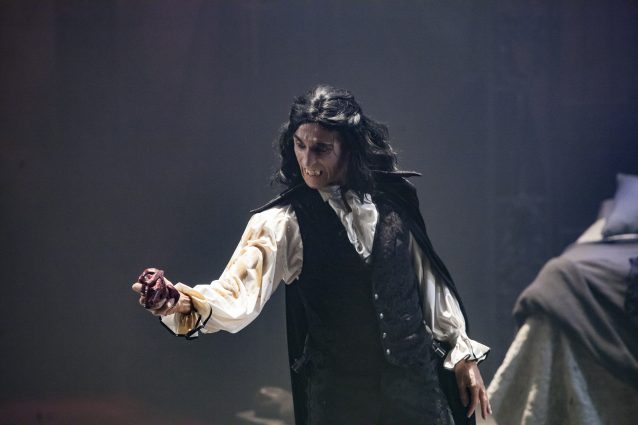Following on the heels of the exuberant, lighthearted staging of “A Midsummer Night’s Dream,” Cincinnati Shakespeare Company‘s production of “Dracula” is a perfect contrast, showcasing the sheer range of potential the Otto M. Budig Theater provides. Steven Dietz’s adaptation of Bram Stoker’s Gothic novel is no comedy. With few exceptions, the endearing schlock that often accompanies vampire stories is notably absent. This is a play that shows respect for the dead—or, more accurately, the undead.
Despite the eponymous Dracula’s ubiquity in pop culture (especially around this time of year), the original story is often remembered in bits and pieces—the stake through the heart, the propensity for daytime naps in a coffin, the fact that Transylvania, to most of us, is known almost exclusively as a home for vampires. This version begins with a brief prologue by Renfield, an asylum inmate who eats insects and birds in an attempt to consume their life force. Billy Chace strikes a perfect balance between torment and maniacal glee with his portrayal of this character, providing most of the comic relief as well as some of the more disturbing moments.

From, there, we’re introduced to Mina and Lucy, two young women discussing their love lives. Mina’s fiance, Jonathan Harker, is on a business trip in the ominous Carpathian estate of a reclusive Count in Transylvania. Meanwhile, Lucy has attracted the attention of not one, but three different suitors. One of these is Dr. Seward, administrator of the asylum that hosts Renfield. When Lucy begins suffering a mysterious illness characterized by paleness, fatigue, disturbing dreams, sleep-walking and a strange mark on her neck, the doctor summons his mentor, Abraham Van Helsing, who specializes in, shall we say, unconventional medicine.
Mina leaves the country to fetch her fiance from a hospital in Budapest, where he is suffering from feverish visions and uncertain memories of his time in the home of Count Dracula. He slowly recovers, asking Mina to keep his journal away from him lest he remember the horrors that drove him to madness in the first place. Lucy’s condition deteriorates, and it becomes clear to Van Helsing that the journal contains answers. Finally, he comes to the conclusion that Count Dracula is a vampire who subsists on the blood of the living. What’s worse, he is now in London and has become young thanks to a feast of (literal) young blood.

The highlight of the performance is, as it always should be, the portrayal of Dracula. The character is such a cliché by now that he is typically either played in a cheeky, self-aware parody or in a way that falls flat. Not so with Giles Davies. He gives Count Dracula the aristocratic poise and menacing presence the character deserves. His confidence is overwhelming. When Dracula is on stage, your eyes are constantly drawn to him. The Count is undeniably a monster, but the fear he exploits is a fear of the erotic. A fear, to be frank, of foreigners coming to England and seducing innocent women. That point is made abundantly clear when his attacks on Lucy and Mina are depicted on stage. To put it delicately, “Dracula” is not intended for young children.

With very few exceptions, everything about Cincinnati Shakespeare Company’s production of “Dracula” works precisely as it’s supposed to. Miranda McGee and Caitlin McWethy hit all the right notes as ostensibly prim 19th Century ladies coming under a vampire’s sway. A constant haze dims the audience’s view of the stage. The costume design is perfectly tailored to the narrative, with deep reds accentuating some of the more lascivious scenes and, of course, plenty of Gothic black. And the cherry on top of this delightfully terrifying experience: Dracula’s three Vixens crept so quietly out from their hiding places that an audience member actually screamed.
“Dracula” runs through November 4 and is just what you need this Halloween season. Performances are located at The Otto M. Budig Theater, 1195 Elm Street in OTR. Tickets are available online now at cincyshakes.com or by calling the box office 513.381.2273.
Zach Moning is the communications manager at ArtsWave. Reach him here with questions or comments about ArtsWave Guide